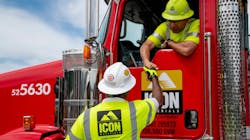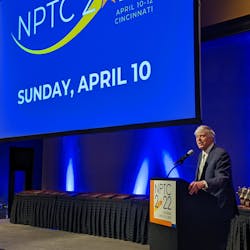CINCINNATI—What do professional truck drivers want? If you asked 100 drivers, you might get 100 different answers. But just asking drivers can give fleets an advantage in finding and keeping the good ones.
That was a common theme among fleet executives who spoke with FleetOwner on April 10, during the opening day of NPTC 2022, the National Private Truck Council’s annual conference here.
“It’s not one thing that drivers want—not everybody wants the same thing—it’s no different than what you want out of life or what I want out of life. It’s probably a little bit different,” said Scott Willert, who was named the NPTC 2022 Private Fleet Executive of the Year during a luncheon ceremony earlier in the day.
Willert is president of America’s Service Line, the private fleet for America’s Food Group, which processes more than 5 million pounds of beef every day. The fleet has about 250 Class 8 trucks and 250 drivers to operate them. The company runs a mix of local, regional, and long-haul routes. “The drivers dictate what they need from a home-time perspective,” Willert told FleetOwner. “I have drivers that stay out for three months at a time, and I have drivers that are home every week. Then I have regional drivers that might be home every day.”
See also: Fleets make moves to attract the next generation of drivers
The biggest key to ASL’s retention comes during the recruiting process. “Getting to know the drivers, telling them what we’re able to offer, and finding out what their needs are,” Willert explained. “If we can agree on that in the front end, we can do well together.”
During that recruitment process, Willert said his team would tell drivers if the fleet would be able to meet their needs. “We’ll tell them if it isn’t going to work,” he said. “We’re not going to make you promises we can’t keep. That’s our philosophy. That’s our strategy.”
Driver pay on the rise
“Drivers, no matter if they’re for-hire or private fleet, are looking for pay, equipment, and home time,” Frantz said. “Our lanes are made for that. Our trade cycles are made for that. And now our compensation is.”
That compensation, he added, is focused on the total package: Along with mileage or hourly pay rate, ADM is highlighting its matching 401K program, along with health insurance and other benefits.
ADM has 500 liquid bulk tankers with 700 drivers operating Class 8s and another 200 in straight trucks. Along with the finished food products the fleet hauls in its tankers, the company has animal feed division and grain commodity divisions “that start in the field and bring that to the processors that we own, and then the trucking lines take it the final step to the customers,” Frantz said.
ASL’s average driver pay is $85,000, Willert said. Many of his drivers make six figures. That’s a pay package that most college graduates don’t see right out of school, noted Al Barner, SVP of strategic fleet solutions at Fleet Advantage. “When you start to look at the driver market and the compensation that these folks are starting to make—or can make—it’s a very appealing job,” he told FleetOwner.
“Here at NPTC, one of the things that we’ve discussed is the culture of private fleets,” he said. “How you bring drivers on board and entice them to come on board, first and foremost, through nice equipment, a good compensation package, and a good corporate culture. But you also want to keep them on board by making sure you’re refreshing the fleet on a regular basis. Make sure you have good morale within the driver force—as well as having a good management structure with open communication.”
What professional drivers want
Asking drivers what they want has changed how CRH Americas—one of the largest building materials companies on the continent—specs its equipment. The company manufactures building materials, products, and solutions for construction projects.
In the past, CRH was worried about its trucks being good construction vehicles. But now the fleet is spec’ing out more ergonomic designs in the truck cabs, premium air-ride seats, adding satellite radio, and disc brakes—things that drivers request. “If they come to me [with] an idea that’s within reason, I’ll spec the truck that way for them,” Randy Maddox, America’s region mobile equipment category manager at CRH, told FleetOwner.
It’s a busy time for Maddox’s division, which delivers concrete-related products, such as road pavers and concrete blocks. The giant company has nearly 200 affiliates in North America that employ about 8,500 drivers with about 9,000 over-the-road vehicles. “That ranges from regional day-cab tractors, straight trucks, flatbeds, and also ready-mix trucks to dump haulers to tri-axles,” Maddox said. “If it can be made from Class 5 to 8, we’ve probably got it somewhere in our fleet.”
See also: Biden admin details plan to boost truck driver jobs
NPTC president and CEO Gary Petty told FleetOwner that many NPTC member fleets are recruiting drivers from elsewhere in the company, such as warehouses. “It’s very common because the worker can make so much more money as a driver,” he noted. “Not everybody in the warehouse is going to be a good driver, but you can pull 20% to 25%.”
Maddox added that those potential drivers in warehouses could be good fits because they already know the company culture. “They know what we want, and they know the customer base,” he said. “So that part’s already there. Now we just got to train them on the driving side. And they can keep their benefits.”
As construction work continues to pick up across the country, CRH has been working to hire more drivers and find more equipment. “That's a challenge simply because it’s a competitive market right now,” Maddox explained. He was named the 2022 NPTC Private Fleet Member of the Year during the opening session of the conference at the historic Hilton Netherlands Plaza in downtown Cincinnati.
To compete, CRH has also focused on bolstering its driver compensation package, which includes its health care and home-time offerings. But Maddox said they made a big push to improve driver comfort. “I’ve changed a lot of the specs of the equipment to provide them the best of the best,” he said. “I used to focus on getting the truck to the job site and turn and make it last. Now I'm focusing on driver creature comforts inside that cab. Maybe my trade cycles are a little shorter than they used to be simply because I got a guy trying to make a decision between me and another company.”
Change in fleet spec’ing in the cab and on the road
ADM’s Frantz said an important thing for the trucking industry, as a whole, is to ensure that drivers have good facilities—at fleet terminals, at customer sites, and along the road. “They’re not looking for high-rent, top-of-the-mark stops,” he explained. “They just want somewhere where they can do basic bookkeeping, hygiene, whatever it is. Customers are going to have to have a place for drivers.’
Modern truck stops have increased driver expectations for amenities, Frantz added. “Terminals for many carriers are now being overhauled,” he said. “We really need to get [shipping] customers on board because when you get to a customer and wait six, eight hours, you’re going to need to get out of that truck. If we could solve that part of the equation, it would be easier to bring drivers in.”
Mike Willey, assistant GM at PacLease, told FleetOwner that fleets’ focus on driver comforts has changed recently. Years ago, companies weren’t willing to pay for the “creature comforts” Maddox has been delivering to his drivers.
“We’ve been talking about a driver shortage for a decade now,” Willey said. “And they always wanted the exact same thing but nobody ever did it because of the cost. Now there is a true driver shortage—and they’re actually willing to invest not only in driver salaries but in additional equipment and nicer trucks.”
Willey pointed to a couple of newer Paccar medium-truck models on display at the NPTC exhibit, the Kenworth T280 and Peterbilt 536. “This truck was designed because we didn’t have a cab size that was comfortable for them," he said. "When I asked a customer what they wanted in the cab years ago, it was the exact same things they want now—but they weren’t willing to pay for the options. And that was OK until they started losing drivers. Now they’re spec’ing without regard to price for some of those features.”
Making a match
ASL’s Willert said that while equipment procurement is more challenging this year, his fleet’s oldest trucks were built in 2020. “So we always have newer trucks for drivers,” he said.
And while most drivers do want new equipment, Willert said there’s a misnomer that every driver wants a regional route that gets them home at night. But they all want to be heard. “It’s about having that conversation and understanding what they want: what their needs are from a personal life, home-time perspective, what their needs are from a compensation perspective, from a benefits perspective,” he said.
“All those things and understanding them as a person go toward us knowing if we can be a good match for them as an employer,” Willert continued. “We’re not looking for drivers that have had three jobs in the past year anyhow. But if we’re not clicking 100%, if we don’t feel that we’re going to have a good partnership here, they’re not going to stay anyhow.”
See also: How to appeal to a changing truck driver demographic
But that doesn’t mean Willert is requiring long-term commitments from new drivers. A few years ago, a 23-year-old driver applied for a job with the fleet, which is usually a younger age than ASL likes to hire. But he had decent driving experience, Willert said.
When Willert spoke to the applicant about his career goals, he found out the young man, who lived at home with his parents, wanted to save money and become an airline pilot. “He said, ‘I’d like to work here for four years, make as much money as I can make, and then I want to go be a pilot,’” Willert recalled. “I stayed connected with him through the whole four years. Recently, he left us to go be a pilot.”
“This kid was making $95,000 to $100,000 a year, living at home, no expenses, socking it all away. I mean, he’s a kid that gets it. He had a boatload of money put away after four years and went to follow his dream,” Willert said. “So we felt good, as much as I hated to see him go.”
About the Author
Josh Fisher
Editor-in-Chief
Editor-in-Chief Josh Fisher has been with FleetOwner since 2017. He covers everything from modern fleet management to operational efficiency, artificial intelligence, autonomous trucking, alternative fuels and powertrains, regulations, and emerging transportation technology. Based in Maryland, he writes the Lane Shift Ahead column about the changing North American transportation landscape.



